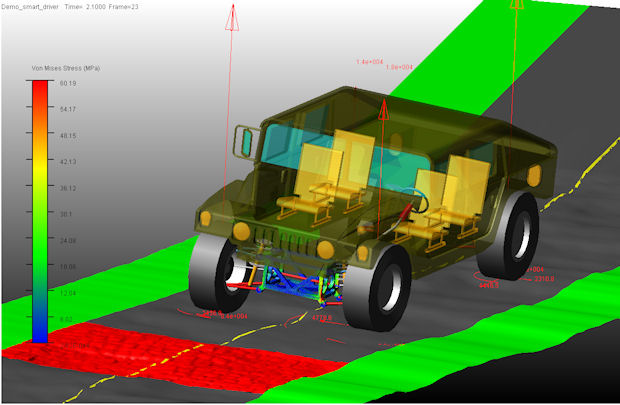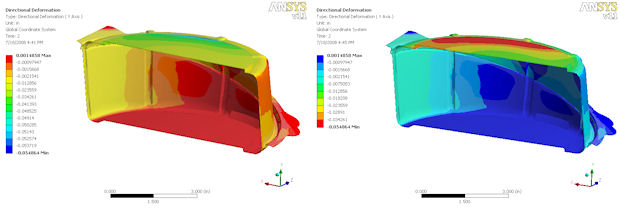
Including flexibility in some of the critical components in a Humvee suspension system contributes to the accuracy of Road Loads predictions performed with MSC Software mechanical simulation products. Image courtesy MSC Software.
Latest News
May 1, 2014
- Including flexibility in some of the critical components in a Humvee suspension system contributes to the accuracy of Road Loads predictions performed with MSC Software mechanical simulation products.
Image courtesy MSC Software.
Consultants can be lifesavers, or at least project-savers. The above questions and others form great starting points for successfully partnering with outside help, whether a one-person business or a service with multiple experts and locations. Here are the must-do steps for a great outcome.
1. Decide whether you even need a consultant.
Time, resources and experience are at the core of why companies seek outside analysis help, says Nagi Elabbasi, managing engineer at Veryst Engineering, a consultancy with special emphasis on coupled and nonlinear systems.
“The client needs a quick turnaround, the client has a problem requiring expertise and/or equipment that it does not have, and/or the client needs the solution to a complex problem requiring specific expertise,” he explains, noting that’s when it’s clear “that the service provider knows the field better than anyone else.”
Sometimes it’s just a matter of project scheduling—you own analysis software, but you’re short on time and simply need someone to get the task done, for example. The in-house team can focus on other areas, or take the time to build up internal experience to do the next job themselves.
Often a company, regardless of size, does analysis infrequently and can’t justify developing in-house capabilities. Derek Barkey, senior manager of consulting for MSC Software, points out that it’s not just about the cost of the software.
“You have to consider getting the tools, getting the training, and adding the headcount,” he explains. “If it’s something they’re going to do on a regular basis, maybe it makes sense to make that investment. If they’re only going to do analysis occasionally, then maybe it’s more cost-effective to let someone else do it.”
Many projects require niche expertise, from understanding the properties of composite materials to predicting the wear effects of water flow on a structure. Consultants generally have more time to focus on details that go beyond your everyday workflow; they know the latest in code compliance and standards, or the tradeoffs that can optimize system-level behavior. Even companies well versed in general structural or fluid dynamics analysis may simply not have the depth to thoroughly perform such specific tasks.
One additional, very good reason exists for looking to outside expertise: creativity.
“When people go outside for engineering services,” says Tony Norton, executive vice president of Altair’s ProductDesign team, “it’s often to get ‘fresh eyes’ on the problem, to get innovation injected into their product development process.” The Altair subsidiary specializes in thinking outside of the box, using a simulation-driven design approach to employ CAD and CAE in parallel. Its engineers tackle such jobs as upfront geometry optimization for weight reduction, prior to detailed dimensioning.
2. Be confident you’re choosing the right company by asking the right questions up front.
Fundamentally, the Top 2 considerations are: can they do what you want, and can you work with them? The information you need to decide yes or no, then, comes from answers to such questions as posed by Nick Veikos, president of CAE Associates, a company that since 1981 has applied ANSYS analysis solutions to finite element analysis (FEA) and computational fluid dynamics (CFD) problems:
- Does the consultant have the level of expertise required to help meet the goals of the engagement?
- Have they successfully worked on similar projects?
- What kind of engineering degrees and how many years of experience does the staff have?
- Have they worked with clients whose names you recognize as industry leaders?
- Is the engagement going to be transactional, or are they in a position to be a long-term partner, learning your processes and practices, with the expertise to help in multiple ways?
- Can they effectively articulate their findings to you in a manner you can understand? Will this include insight into your product or process?
- Are they flexible in how they work, and can they easily accommodate changes in scope—common needs in these types of engagements?
- Do they use the best software tools, and have access to sufficient computer hardware to produce the correct answer to your problem in a timely manner?
“If we can do things better and faster, and give you a lower total cost,” he explains, “then the total cost and its value are what’s important.”
Added value can take many forms. O’Donnell Consulting, for example, specializes in analyzing designs of vessels, turbines, shafts, ductwork, heat exchangers and turbo machinery. Drawing upon the company’s 44 years of engineering experience, Bill O’Donnell, vice president of marketing, says, “Knowledge of fatigue and fracture properties is essential to evaluate structural integrity.” His company adds value by offering interdisciplinary expertise in structural, materials, fabrication, welding technology, metallurgy and FEA.3. Determine the path that starts at proposal and ends with results.
Clients come to a consultant because they have a problem that ideally translates into a specific analysis or experiment.
“Our job is to solve their problem and act in their best interest,” says Veryst’s Elabbasi. “Sometimes we find that a different course of action is more suitable; we must communicate that to the client—even if it means someone else should provide assistance.”
Tom Marinaccio is senior vice president, worldwide engineering services, at CD-adapco, a global engineering company with particular expertise in flow/thermal software development and applications. He agrees, saying, “Remember, no one ever just wants ‘an analysis’; they need the analysis to answer certain questions or to use as an example to learn how an experienced supplier approaches the simulation.” He asks clients, “‘What do you want to know at the end of the engagement that you do not know now?’ The more we understand the objectives, the better.”
 An analysis project for the improvement of a plastic cake container, done by CAE Associates for Inline Plastics Corporation. The goal was to optimize the cake-container design with respect to material use and product visibility while maintaining sufficient structural stiffness of the container during shipping and handling. CAE Associates used ANSYS Workbench to create the FEA model. Using a statistical approach, the company analyzed hundreds of design scenarios to produce a table of product geometries optimized for various client-driven goals. Images courtesy CAE Associates.
An analysis project for the improvement of a plastic cake container, done by CAE Associates for Inline Plastics Corporation. The goal was to optimize the cake-container design with respect to material use and product visibility while maintaining sufficient structural stiffness of the container during shipping and handling. CAE Associates used ANSYS Workbench to create the FEA model. Using a statistical approach, the company analyzed hundreds of design scenarios to produce a table of product geometries optimized for various client-driven goals. Images courtesy CAE Associates.A well-defined project must include simulation objectives, a proposed timeline and specific deliverables. If test results are at hand, reports on manufacturing tolerances, failure modes and supplier data should also be provided.
“The more details, the better,” says CAE Associates’ Veikos. “The relevant geometry, material data, loading and all other data should be made available up front. This way, it will be clear what data is missing, providing the maximum amount of lead time for acquiring it.”
4. Communication and progress tracking are critical.
Consultants often break a project into one-month sections with defined deliverables, making weekly phone calls to discuss progress. Although face-to-face meetings or site visits are helpful, working with a geographically distant consulting company is comparable to using a local one. Quick emails, easy file transfers, multi-site conference calls, and Skype, Webex or GoToMeeting videoconferencing can all keep the job moving smoothly.
Some projects have crisp statements of work (SOW) and specific milestones; for others, the milestones aren’t as clear. Even when deliverables seem well defined, MSC Software’s Barkey says consultants must ask, “How good is good enough?” and put in decision gates—setting a certain amount of time after which to decide, for example, should we now refine one of these four design concepts, or evaluate yet others?
5. Ensure that the analysis you receive is valid.
Validation (they’re solving the right model) and verification (they’re solving that model correctly) are both important aspects of the analysis to monitor. To do so, depending on the size of a project, you may first hire an engineering service to set up a pilot program. Paul Goossen, vice president of engineering solutions at Maplesoft, suggests you could even work in parallel, compare results to your satisfaction, and then have the confidence to turn over the complete program. Or, going in the other direction, the goal could be knowledge transfer so that eventually you’d do analyses yourself.
Either way, you should insist on seeing some type of basic hand calculation to ensure the results are in the ballpark. Goossen says analysts should be able to expose the equations they are using—and even point to relevant papers on the subject so you can see the rigor of their approach. Look, too, for clear definitions of the loading, boundary conditions, material models and simplifying assumptions that went into the analysis.
“You should review some type of numerical confirmation of the results, such as mesh density effects, heat and force balance, etc.,” Veikos states. “If the results are counterintuitive, possibly also benchmark the analysis results for a similar component that has already been tested.”
6. Make sure you’re comfortable with how the company estimates and structures billing.
You should find a company that offers comfortable terms for your needs and budget. Some bill a minimum as low as one day’s work; others do time-and-materials. Most propose contracts with a fixed/not-to-exceed price, including clear, preset milestones. To test the waters, you could always start with a small project first.
7. Find out how security and intellectual property concerns are handled.
Clients are understandably sensitive about their information, so non-disclosure agreements are standard. Consultants take pains to keep data, procedures and results secure, making sure only the engineers working on the project have access.
At large companies, it’s possible that two people may be working on similar projects for two different clients, so keeping firm boundaries is critical. At the same time, if your consultant will be writing custom code for the analysis job, be clear as to who owns the work afterward.
Your New Best Friend
The simulation consultant should provide you with a sounding board as the voice of experience. Be clear about your goals, but open to suggestions—sometimes an initial conversation steers the project onto a much more efficient path. Ultimately, working with an outside analyst should be a productive and satisfying process for both of you.
More Info
Subscribe to our FREE magazine, FREE email newsletters or both!
Latest News
About the Author
Pamela Waterman worked as Digital Engineering’s contributing editor for two decades. Contact her via .(JavaScript must be enabled to view this email address).
Follow DE






